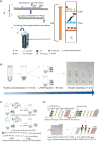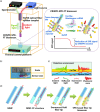Mpox disease, diagnosis, and point of care platforms
- PMID: 40385539
- PMCID: PMC12079464
- DOI: 10.1002/btm2.10733
Mpox disease, diagnosis, and point of care platforms
Abstract
Human Mpox disease (MPX) is an endemic zoonotic disease that develops when patients are infected with the Mpox virus (MPXV). MPXV shares a high level of genetic similarity to other poxviruses and the clinical presentation of MPX is similar to other poxvirus infections which can result in a delay in diagnosis. In addition, the MPXV virus is phylogenetically divided into two different clades which affects the severity of disease. In recent years, there has been an unusual worldwide spread of MPXV, leading to a global public health problem. The most important step in the fight against MPX is rapid, highly specific, and accurate diagnosis. Following the rapid spread of disease in recent years, efforts to develop diagnostic tests have gained momentum. Here, MPX, MPX epidemiology, and MPX diagnostic tests are discussed. Furthermore, biochemical diagnostic tests, molecular diagnostic tests and their development, and point-of-care (PoC) diagnostic applications are reviewed. Molecular diagnostic technologies such as polymerase chain reaction, recombinase polymerase amplification, and loop-mediated isothermal amplification methods that detect MPX are evaluated. Additionally, next-generation combined molecular techniques and their importance in PoC transition are explored.
Keywords: Mpox (MPX); loop‐mediated isothermal amplification (LAMP); point‐of‐care (PoC) applications; polymerase chain reaction (PCR); recombinase polymerase amplification (RPA).
© 2024 The Author(s). Bioengineering & Translational Medicine published by Wiley Periodicals LLC on behalf of American Institute of Chemical Engineers.
Conflict of interest statement
The authors declare no conflicts of interest.
Figures





Similar articles
-
Loop-mediated isothermal amplification combined with lateral flow biosensor for rapid and sensitive detection of monkeypox virus.Front Public Health. 2023 Mar 24;11:1132896. doi: 10.3389/fpubh.2023.1132896. eCollection 2023. Front Public Health. 2023. PMID: 37033067 Free PMC article.
-
Evaluation of the diagnostic accuracy of Xpert® Mpox and STANDARD™ M10 MPX/OPX for the detection of monkeypox virus.J Infect. 2025 Feb;90(2):106413. doi: 10.1016/j.jinf.2025.106413. Epub 2025 Jan 15. J Infect. 2025. PMID: 39824291 Free PMC article.
-
Ultrasensitive and Specific Identification of Monkeypox Virus Congo Basin and West African Strains Using a CRISPR/Cas12b-Based Platform.Microbiol Spectr. 2023 Feb 22;11(2):e0403522. doi: 10.1128/spectrum.04035-22. Online ahead of print. Microbiol Spectr. 2023. PMID: 36821485 Free PMC article.
-
Monkeypox (mpox) virus: Classification, origin, transmission, genome organization, antiviral drugs, and molecular diagnosis.J Infect Public Health. 2023 Apr;16(4):531-541. doi: 10.1016/j.jiph.2023.02.003. Epub 2023 Feb 9. J Infect Public Health. 2023. PMID: 36801633 Free PMC article. Review.
-
Comprehensive literature review of monkeypox.Emerg Microbes Infect. 2022 Dec;11(1):2600-2631. doi: 10.1080/22221751.2022.2132882. Emerg Microbes Infect. 2022. PMID: 36263798 Free PMC article. Review.
Cited by
-
LAMPOX: A Portable and Rapid Molecular Diagnostic Assay for the Epidemic Clade IIb Mpox Virus Detection.Diagnostics (Basel). 2025 Aug 4;15(15):1959. doi: 10.3390/diagnostics15151959. Diagnostics (Basel). 2025. PMID: 40804923 Free PMC article.
References
-
- Jin B, Ma C, Zhang C, et al. Point‐of‐care detection of Monkeypox virus clades using high‐performance upconversion nanoparticle‐based lateral flow assay. Mikrochim Acta. 2024;191(4):177. - PubMed
-
- Yan H, Su JY, Tian L, et al. A rapid and sensitive fluorescent chromatography with cloud system for MPXV point‐of‐care diagnosis. Anal Chim Acta. 2024;1302:342514. - PubMed
Publication types
LinkOut - more resources
Full Text Sources

